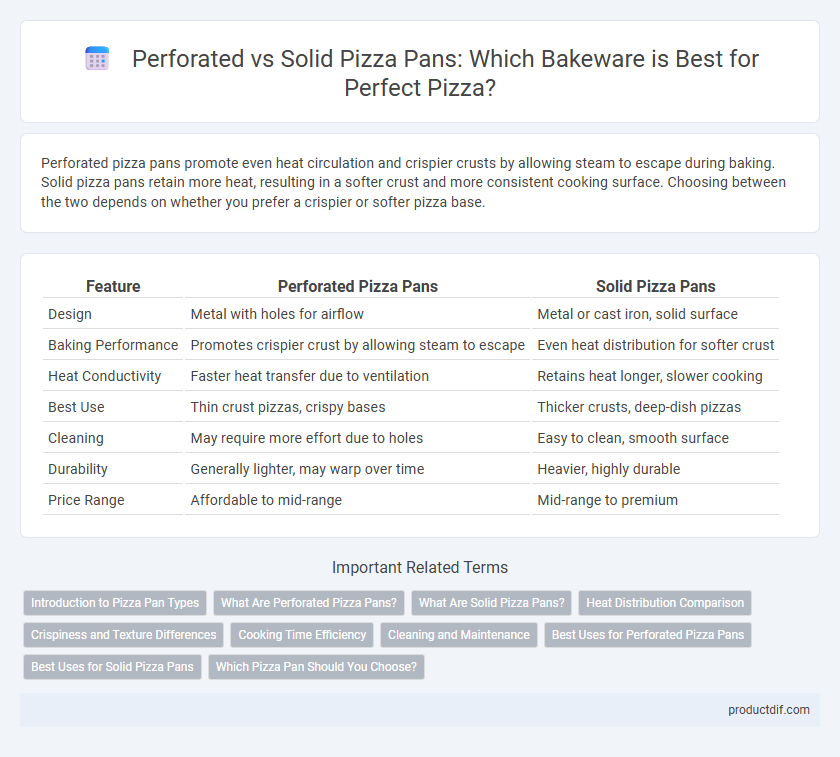Perforated pizza pans promote even heat circulation and crispier crusts by allowing steam to escape during baking. Solid pizza pans retain more heat, resulting in a softer crust and more consistent cooking surface. Choosing between the two depends on whether you prefer a crispier or softer pizza base.
Table of Comparison
| Feature | Perforated Pizza Pans | Solid Pizza Pans |
|---|---|---|
| Design | Metal with holes for airflow | Metal or cast iron, solid surface |
| Baking Performance | Promotes crispier crust by allowing steam to escape | Even heat distribution for softer crust |
| Heat Conductivity | Faster heat transfer due to ventilation | Retains heat longer, slower cooking |
| Best Use | Thin crust pizzas, crispy bases | Thicker crusts, deep-dish pizzas |
| Cleaning | May require more effort due to holes | Easy to clean, smooth surface |
| Durability | Generally lighter, may warp over time | Heavier, highly durable |
| Price Range | Affordable to mid-range | Mid-range to premium |
Introduction to Pizza Pan Types
Perforated pizza pans feature small holes that promote even heat circulation and crispier crusts by allowing steam to escape during baking. Solid pizza pans provide a uniform surface for cooking, retaining moisture and producing softer crusts ideal for thicker pizza styles. Choosing between perforated and solid pizza pans depends on desired crust texture and cooking preferences.
What Are Perforated Pizza Pans?
Perforated pizza pans feature numerous small holes across their surface, allowing heat to circulate evenly and moisture to escape, resulting in a crispier crust. These pans are typically made from aluminum or steel for optimal heat conduction and durability. Ideal for achieving a traditional pizzeria-style crust, perforated pans help prevent sogginess by promoting airflow during baking.
What Are Solid Pizza Pans?
Solid pizza pans are made from a continuous sheet of metal, typically aluminum or steel, providing even heat distribution for a uniformly cooked crust. These pans lack holes, which results in a softer and chewier pizza base by retaining moisture during baking. Preferred for thick-crust and deep-dish pizzas, solid pans ensure consistent cooking without crisping the bottom excessively.
Heat Distribution Comparison
Perforated pizza pans offer superior heat distribution by allowing hot air to circulate evenly through the holes, resulting in a crispier crust. Solid pizza pans retain heat uniformly across their surface, promoting consistent cooking but can cause a slightly softer bottom crust. Choosing between the two depends on whether a crisp texture or even heat retention is preferred for the desired pizza outcome.
Crispiness and Texture Differences
Perforated pizza pans enhance crispiness by allowing heat and air to circulate directly underneath the dough, resulting in a crunchier crust and more evenly textured pizza. Solid pizza pans retain moisture, producing a softer, chewier texture ideal for thick or deep-dish styles. Choosing between perforated and solid pans depends on the desired balance between crispiness and dough softness for specific pizza types.
Cooking Time Efficiency
Perforated pizza pans improve cooking time efficiency by allowing better airflow and heat circulation, resulting in crisper crusts and faster bake times compared to solid pizza pans. Solid pizza pans retain more moisture, which can extend cooking times but may yield a softer crust. Choosing a perforated pan is ideal for those seeking quicker, evenly baked pizzas without sacrificing texture quality.
Cleaning and Maintenance
Perforated pizza pans allow grease and moisture to drain away, reducing buildup and making surface cleaning quicker and easier compared to solid pizza pans, which can trap residue and require more thorough scrubbing. Solid pans benefit from their uniform surface, allowing simple wipe-downs but often necessitate soaking to remove baked-on dough or cheese. Both types require regular maintenance to prevent rust and maintain non-stick properties, with perforated pans needing extra care to clear holes of debris.
Best Uses for Perforated Pizza Pans
Perforated pizza pans are ideal for achieving a crispy crust by allowing hot air to circulate and moisture to escape during baking, making them perfect for thin-crust pizzas. The holes in the pan reduce sogginess, especially when using fresh or high-moisture toppings. These pans are also great for evenly browning the pizza base and shortening the overall cooking time.
Best Uses for Solid Pizza Pans
Solid pizza pans offer even heat distribution, making them ideal for achieving a uniformly cooked crust, especially with thick or deep-dish pizzas. Their continuous surface prevents toppings from dripping through, ensuring a clean oven and well-contained pizza. These pans work best for recipes that require a chewy, dense crust and consistent baking without the need for extra airflow.
Which Pizza Pan Should You Choose?
Perforated pizza pans provide superior heat circulation, resulting in a crispier crust, making them ideal for thin, crunchy styles. Solid pizza pans retain more moisture and heat evenly, perfect for thicker, chewier pizzas like deep-dish or pan-style. Choose a perforated pan for crisp texture or a solid pan for softer, more uniform baking results.
Perforated Pizza Pans vs Solid Pizza Pans Infographic

 productdif.com
productdif.com